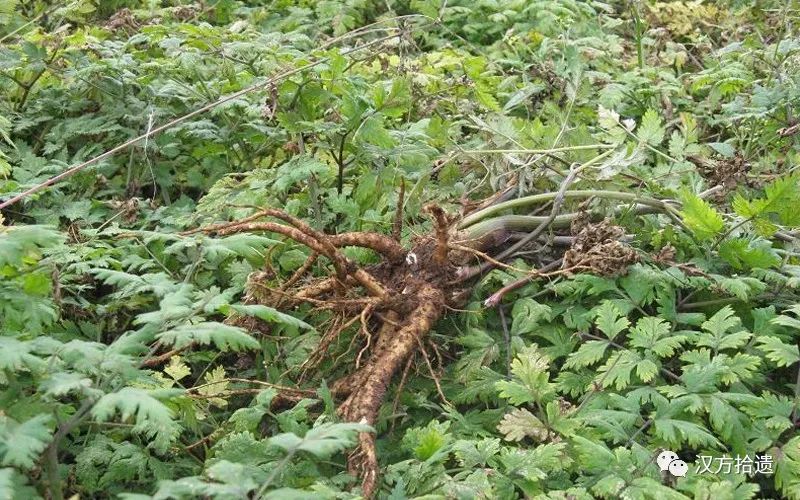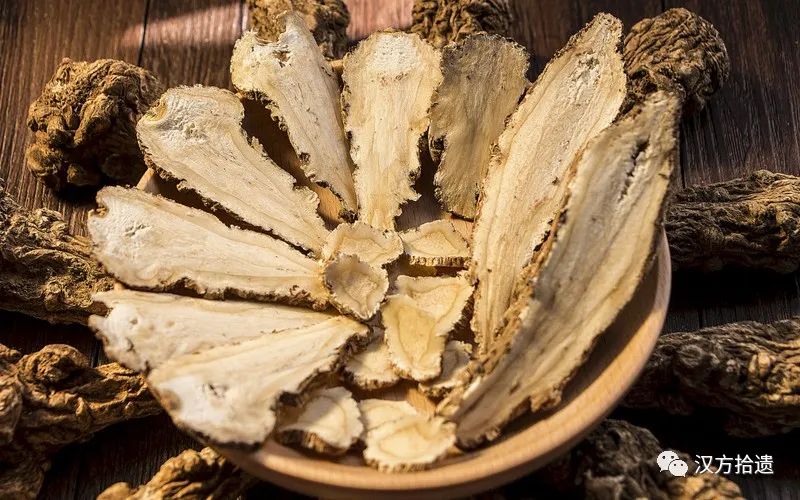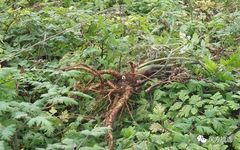“Angelica Sinensis, known as Dang Gui in Chinese medicine, is also referred to as Gan Gui, Ma Wei Dang Gui, Qin Gui, Ma Wei Gui, Yun Gui, Xi Dang Gui, and Min Dang Gui. It is the root of the plant Angelica sinensis (Oliv) Diels, belonging to the Apiaceae family. It is known for its ability to nourish blood, regulate menstruation, invigorate blood circulation, relieve pain, and moisten the intestines to alleviate constipation. It is primarily used to treat blood deficiency, menstrual irregularities, dysmenorrhea, various pains due to blood deficiency, blood stasis, and blood cold, as well as injuries, rheumatic pain, carbuncles, and constipation due to dryness of the intestines.”
Properties and Channels
Sweet and pungent in flavor, warm in nature; it enters the Liver, Heart, and Spleen channels.

01
—
Functions and Effects
Functions
Nourishes blood, invigorates blood circulation, regulates menstruation, and relieves pain.
Indications
1. Used for blood deficiency, pale complexion, menstrual irregularities, dysmenorrhea, various pains due to blood deficiency, blood stasis, and blood cold, as well as injuries, rheumatic pain, carbuncles, and constipation due to dryness of the intestines.
2. In Western medicine, it is indicated for anemia due to heart and liver blood deficiency, endometritis, functional uterine bleeding, threatened abortion, habitual abortion, and postpartum hemorrhage due to blood deficiency and stasis, deep muscle abscesses due to blood deficiency, habitual constipation, and constipation in the elderly or postpartum.
Dosage and Administration
For internal use: decoction, 6-12g; can also be used in pills, powders, soaked in wine, or applied as a plaster.
Contraindications
1. Contraindications for combining with Western medicine:
(1) Should not be used with antihypertensive drugs to prevent orthostatic hypotension.
(2) Combining with heparin, warfarin, aspirin, etc., may increase the risk of bleeding.
2. Dietary contraindications: Avoid wheat products.
Precautions
Should not be taken by patients with heat-induced bleeding; use with caution in those with dampness and fullness or loose stools.
Chemical Composition
Angelica Sinensis contains β-pinene, α-pinene, camphene, and other neutral oil components. It also contains p-methylbenzyl alcohol, 5-methoxy-2,3-dimethylphenol, organic acids, sugars, vitamins, amino acids, etc.
Pharmacological Effects
1. Effects on the reproductive system: Angelica Sinensis has a bidirectional regulatory effect on uterine smooth muscle. It primarily inhibits isolated uterine contractions while stimulating contractions in vivo.
2. Effects on the cardiovascular system: The flow extract of Angelica Sinensis has anti-myocardial ischemia effects, and its neutral oil protects against myocardial ischemia. It also has anti-arrhythmic effects and can dilate coronary arteries, increasing coronary blood flow.
3. Effects on the blood system: Angelica Sinensis powder can lower blood lipids and has protective effects against arterial sclerosis. Extracts of Angelica Sinensis contain ligustilide, which inhibits platelet aggregation. Angelica Sinensis and its ferulic acid have significant anti-thrombotic effects. The polysaccharides in Angelica Sinensis promote hematopoiesis.
4. Effects on the immune system: The total acids in Angelica Sinensis enhance both cellular and humoral immune functions. The polysaccharides also have immune-enhancing effects.
5. Effects on the central nervous system: The effective component ligustilide in Angelica Sinensis has inhibitory effects on the central nervous system and exhibits analgesic effects, stronger than aminopyrine, with very low acute toxicity.
6. Antimicrobial effects: Angelica Sinensis exhibits antibacterial effects against dysentery, typhoid, paratyphoid, E. coli, diphtheria, cholera, and α, β-hemolytic streptococci.
7. Effects on the respiratory system: The components of Angelica Sinensis have antispasmodic effects.
8. Additionally, Angelica Sinensis has liver-protective, anti-tumor, anti-radiation, anti-inflammatory, kidney-protective, antioxidant effects, and can correct protein metabolism disorders.
Toxicological Effects
Angelica Sinensis has low toxicity, with an LD50 of 80-100g/kg for intravenous injection in mice; the LD50 for subcutaneous injection and oral administration of volatile oil is 298mg/kg and 96mg/kg, respectively; the LD50 for ligustilide via intraperitoneal injection is 520mg/kg; the LD50 for sodium ferulate via intravenous injection and oral administration is 1.7g/kg and 3.6g/kg, respectively. Intravenous injection of 2g/kg in dogs for 14 days showed no significant effects on the liver, kidneys, electrocardiogram, or blood parameters. Mice fed a diet containing 5% Angelica Sinensis for 3-5 months showed robust growth and significantly improved liver oxidative glutamate capacity.
Related Discussions
1. “Shennong Bencao Jing”: Used for cough, counterflow qi, warming malaria, and cold heat washing in the skin. For women with leakage and infertility, and various sores and ulcers.
2. “Bencao Gangmu”: Treats headaches, abdominal pain, moistens the intestines and stomach, muscles and bones, treats carbuncles, drains pus and relieves pain, harmonizes and nourishes blood.
3. “Yixue Qiyuan”: Angelica Sinensis is warm in nature and sweet in flavor, capable of harmonizing and nourishing blood, breaking blood stasis, and harmonizing the body.
02
—
Clinical Applications
Clinical Applications
1. For Qi and blood deficiency: Often combined with Astragalus (Huang Qi) and Ginseng (Ren Shen) to tonify Qi and nourish blood, such as in the Dang Gui Bu Xue Tang (Angelica Sinensis Blood Nourishing Decoction) and Ren Shen Yang Rong Tang (Ginseng Nourishing Decoction).
2. For blood deficiency, pale complexion, palpitations, and insomnia: Commonly combined with Rehmannia (Shu Di Huang), White Peony (Bai Shao), and Chuanxiong (Chuan Xiong), such as in the Si Wu Tang (Four Substance Decoction).
3. For blood deficiency and stasis, menstrual irregularities, dysmenorrhea: Often used with blood-nourishing and menstrual-regulating herbs, such as in the Si Wu Tang. If accompanied by Qi deficiency, it can be combined with Ginseng or Astragalus; if Qi stagnation is present, it can be combined with Cyperus (Xiang Fu) or Corydalis (Yan Hu Suo); if there is blood heat, it can be combined with Scutellaria (Huang Qin), Coptis (Huang Lian), or Peony (Mu Dan Pi) and Rehmannia (Di Gu Pi); if blood stasis causes menstrual obstruction, it can be combined with Peach Kernel (Tao Ren) or Safflower (Hong Hua); if blood deficiency and cold stasis are present, it can be combined with Ejiao (Donkey-hide Gel) or Mugwort (Ai Ye).
4. For abdominal pain due to blood deficiency and cold stasis: Combined with Cinnamon Twig (Gui Zhi), White Peony (Bai Shao), and Ginger (Sheng Jiang), such as in the Dang Gui Sheng Jiang Yang Rou Tang (Angelica Sinensis and Ginger Lamb Soup) and Dang Gui Jian Zhong Tang (Angelica Sinensis and Middle Strength Decoction).
5. For traumatic injuries and pain due to blood stasis: Combined with Frankincense (Ru Xiang), Myrrh (Mo Yao), Peach Kernel (Tao Ren), and Safflower (Hong Hua), such as in the Fu Yuan Huo Xue Tang (Restorative Blood Invigorating Decoction) and Huo Luo Xiao Ling Dan (Invigorating Collaterals and Easing Pain Pill).
6. For initial swelling and pain of sores and ulcers: Combined with Honeysuckle (Jin Hua), Red Peony (Chi Shao), and Trichosanthes (Tian Hua Fen) to detoxify and reduce swelling, such as in the Xian Fang Huo Ming Yin (Immortal Recipe for Life Decoction).
7. For abscesses that are not draining or not healing after drainage: Combined with Astragalus (Huang Qi), Ginseng (Ren Shen), and Cinnamon (Rou Gui), such as in the Shi Quan Da Bu Tang (Ten Complete Great Tonifying Decoction).
8. For gangrene and ulceration with blood deficiency: Can be combined with Honeysuckle (Jin Yin Hua), Scrophularia (Xuan Shen), and Licorice (Gan Cao), such as in the Si Miao Yong An Tang (Four Marvelous Peace Decoction).
9. For wind-cold bi syndrome and numbness of limbs: Should invigorate blood, disperse cold, and relieve pain, often combined with Notopterygium (Qiang Huo), Siler (Fang Feng), and Astragalus (Huang Qi), such as in the Juan Bi Tang (Dispersing Bi Decoction).
10. For blood deficiency and dry intestines causing constipation: Often combined with Cistanche (Rou Cong Rong), Achyranthes (Niu Xi), and Cimicifuga (Sheng Ma), such as in the Ji Chuan Jian (River Flow Decoction).
Related Combinations
1. Angelica Sinensis combined with White Peony: Angelica Sinensis excels in nourishing blood and softening the liver, promoting blood circulation and relieving pain; White Peony is good at nourishing blood and softening the liver, restraining yin and relieving pain. Together, they nourish blood and regulate blood flow, suitable for palpitations due to insufficient heart blood; dizziness and tinnitus due to insufficient liver blood; and menstrual irregularities and dysmenorrhea due to blood deficiency and stasis in women.
2. Angelica Sinensis combined with Cistanche: Angelica Sinensis excels in nourishing blood and moistening the intestines; Cistanche is good at tonifying yang and nourishing yin, moistening the intestines and relieving constipation. Together, they enhance the effect of moistening and relieving constipation, suitable for constipation due to yin deficiency and qi weakness.
3. Angelica Sinensis combined with Rehmannia: Angelica Sinensis nourishes blood and regulates menstruation; Rehmannia nourishes blood and fills essence and marrow. Together, they enhance the effect of nourishing blood and yin, suitable for blood deficiency with yin deficiency symptoms.
4. Angelica Sinensis combined with Schizonepeta: Angelica Sinensis excels in nourishing blood and invigorating blood; Schizonepeta is good at dispersing wind and stopping bleeding. Together, they enhance the effects of nourishing blood and stopping bleeding, dispersing wind and invigorating blood, suitable for postpartum blood deficiency, wind-induced dizziness, and emergency treatment for unconsciousness, or blood deficiency causing wind, with symptoms like limb spasms and skin itching.
5. Angelica Sinensis combined with Red Peony: Angelica Sinensis excels in nourishing blood and softening the liver, promoting blood circulation and relieving pain; Red Peony is good at clearing heat and cooling blood, dispersing stasis and relieving pain. Together, they enhance the effect of invigorating blood and relieving pain, suitable for dysentery-related abdominal pain, blood-stained stools, and disharmony between the liver and spleen with abdominal cramping and persistent pain.
6. Angelica Sinensis combined with Aconite: Angelica Sinensis excels in nourishing blood and softening the liver, promoting blood circulation and relieving pain; Aconite is good at warming the kidneys and strengthening yang, dispersing cold and relieving pain. Together, they enhance the effects of nourishing blood and softening the liver, warming the kidneys and strengthening yang, suitable for long-term unresolved conditions due to spleen deficiency, leading to blood loss and subsequent yang deficiency.
7. Angelica Sinensis combined with Hemp Seed: Angelica Sinensis nourishes blood and invigorates blood circulation, moistening the intestines and relieving constipation; Hemp Seed is sweet, neutral, and oily, also moistening the intestines and relieving constipation. Together, they enhance the effect of moistening the intestines and relieving constipation, suitable for blood deficiency and dry intestines causing constipation.
Distinguishing Medicinal Uses
1. Raw Angelica Sinensis, Wine-processed Angelica Sinensis, Fried Angelica Sinensis, and Charred Angelica Sinensis: The ancient processing methods of Angelica Sinensis include wine processing, vinegar processing, rice frying, soil frying, salt frying, ginger juice processing, and more than 20 others. The commonly used processed forms today are Raw Angelica Sinensis, Wine-processed Angelica Sinensis, Fried Angelica Sinensis, and Charred Angelica Sinensis. Raw Angelica Sinensis is moist and excels in nourishing blood, regulating menstruation, and moistening the intestines, often used for blood deficiency, constipation, and skin sores. Wine-processed Angelica Sinensis is effective in invigorating blood, nourishing blood, and regulating menstruation, often used for blood stasis, dysmenorrhea, and menstrual irregularities. Fried Angelica Sinensis can nourish blood without causing diarrhea, often used for blood deficiency with loose stools and abdominal pain. Charred Angelica Sinensis primarily stops bleeding and regulates blood, often used for excessive menstrual bleeding and blood deficiency. Studies using atomic absorption spectrophotometry have shown that the lead content in processed Angelica Sinensis significantly decreases, with the reduction being: soil-fried Angelica Sinensis ≥ wine-fried Angelica Sinensis > charred Angelica Sinensis > raw Angelica Sinensis. Reports indicate that the effective components are preserved well when Angelica Sinensis is soaked in wine and then sliced, resulting in high-quality slices. The water-soluble content increases after wine processing, but the ferulic acid content does not decrease, while the tannin content in charred Angelica Sinensis is about twice that of raw products. Other literature suggests that the ferulic acid content decreases with increasing processing temperature, especially in charred Angelica Sinensis.
2. Angelica Sinensis head, body, tail, and whole Angelica Sinensis: Angelica Sinensis can be divided into head, body, and tail, which can be used separately (Angelica Sinensis head, body, tail) or combined (whole Angelica Sinensis). Traditional Chinese medicine holds that the head is used for stopping bleeding, the body for nourishing blood, and the tail for breaking blood stasis; whole Angelica Sinensis is used for both nourishing and invigorating blood. Chemical analysis of different medicinal parts of Angelica Sinensis shows that the volatile oil content is: head 0.93%, tail 0.92%; sugar content: head and tail both 5.4%; ash content: head 5.4%, tail 5.0%. However, other reports indicate that based on ferulic acid and volatile oil content, the tail > body > head. X-ray analysis of metal elements shows that the head contains higher levels of calcium, copper, and zinc, while the tail contains higher levels of potassium and iron, with significant differences.
3. Rehmannia and Angelica Sinensis: Both are sweet and warm, entering the Liver channel, and are good at nourishing blood, treating blood deficiency, pale complexion, dizziness, premature graying, palpitations, menstrual irregularities, and dysmenorrhea. However, Rehmannia is slightly warm and moist, good at nourishing yin and filling essence, treating kidney yin deficiency with symptoms like lower back pain, tidal fever, night sweats, and seminal emissions, as well as yin deficiency leading to thirst. Angelica Sinensis is warm and also enters the Heart and Spleen channels, with less moistening nature, good at invigorating blood and regulating menstruation, especially suitable for heavy pain due to blood deficiency and stasis, and treating various conditions before and after childbirth, cold abdominal pain, blood stasis pain, and skin sores that do not heal or take a long time to heal; it can also moisten the intestines, treating blood deficiency and dry intestines causing constipation.
4. Chuanxiong and Angelica Sinensis: Both are pungent and warm, with functions of invigorating blood, regulating menstruation, and relieving pain, treating menstrual irregularities, dysmenorrhea, traumatic swelling and pain, and rheumatic pain due to blood stasis and cold. However, Chuanxiong is an invigorating blood and pain-relieving herb, ascending to the head and descending to the blood sea, with strong qi-moving properties, also good at dispelling wind and relieving pain, especially suitable for headaches and rheumatic pain, liver qi stagnation, and hypochondriac pain, effective for all types of headaches, whether due to wind-cold, wind-heat, or blood stasis. Angelica Sinensis is a blood-nourishing herb, sweet and warm, good at nourishing blood, also moistening the intestines, suitable for all symptoms of blood deficiency, blood stasis with cold, and dry intestines, especially effective for blood deficiency, qi and blood deficiency, cold abdominal pain, and skin sores.
5. Peach Kernel and Angelica Sinensis: Both can invigorate blood, regulate menstruation, and moisten the intestines, treating gynecological blood stasis, dysmenorrhea, postpartum abdominal pain, traumatic swelling, and constipation due to dry intestines. However, Peach Kernel is an invigorating blood and regulating menstruation herb, neutral and sweet-bitter, good at breaking stasis and generating new blood, also effective for cough and asthma, treating intestinal abscesses, lung abscesses, blood accumulation leading to mania, and cough with asthma. Angelica Sinensis is sweet, warm, and nourishing, good at treating blood deficiency or qi and blood deficiency, cold abdominal pain, rheumatic pain, and skin sores.
6. Sanqi and Angelica Sinensis: Both are sweet and warm, entering the Liver and Heart channels, capable of invigorating blood and relieving pain, treating traumatic swelling and abdominal pain due to blood stasis. However, Sanqi is a blood-activating and hemostatic herb, slightly bitter and entering the Stomach channel, with nourishing properties, effective for various internal and external bleeding, especially for those with stasis; it is also effective for cerebrovascular diseases and chronic hepatitis. Angelica Sinensis is pungent and enters the Spleen channel, excelling in nourishing blood, regulating menstruation, moistening the intestines, and treating blood deficiency or qi and blood deficiency, cold abdominal pain, rheumatic pain, and skin sores.
7. Chicken Blood Vine and Angelica Sinensis: Both are sweet and warm, entering the Liver channel, with functions of nourishing blood, invigorating blood, and regulating menstruation, treating blood deficiency and pale complexion, as well as menstrual irregularities, dysmenorrhea, and traumatic injuries, blood stasis pain, rheumatic pain, and stroke paralysis. However, Chicken Blood Vine is bitter and enters the Kidney channel, with weaker medicinal properties, good at relaxing tendons and activating collaterals, suitable for blood stasis or obstruction of vessels. Angelica Sinensis is pungent and enters the Heart and Spleen channels, with stronger medicinal properties, also effective for pain relief, especially for heavy pain due to blood stasis and cold, treating cold abdominal pain, initial swelling of sores, or sores that do not heal or take a long time to heal; it can also moisten the intestines, treating blood deficiency and dry intestines causing constipation.
8. Cistanche and Angelica Sinensis: Both have the effect of moistening the intestines and relieving constipation, suitable for dry intestines and constipation. However, Cistanche is a yang-tonifying herb, sweet and slightly warm, entering the Kidney and Large Intestine channels, capable of tonifying Kidney yang, nourishing essence and blood, thus also treating Kidney yang deficiency, blood deficiency, impotence, lower back pain, weakness of the muscles and bones, and infertility due to cold. Angelica Sinensis is a blood-nourishing herb, sweet and warm, excelling in nourishing blood, also moistening the intestines, suitable for all symptoms of blood deficiency, blood stasis with cold, and dry intestines, especially effective for blood deficiency, qi and blood deficiency, cold abdominal pain, and skin sores.
Related Medicinal Products
Angelica Sinensis flow extract, Angelica Sinensis blood-nourishing oral liquid (pills), Angelica Sinensis nourishing blood pills, Angelica Sinensis bitter herb pills, Angelica Sinensis dragon and aloe pills.
Related Formulas
Angelica Sinensis Blood Nourishing Decoction (“Nei Wai Shang Bian Huo Lun”), Angelica Sinensis Four Reverse Decoction (“Shang Han Lun”), Huo Luo Xiao Ling Dan (“Medical Records of Traditional Chinese Medicine”), Sheng Hua Tang (“Fu Qing Zhu Nu Ke”), Angelica Sinensis Six Yellow Decoction (“Lan Shi Mi Cang”).
Dietary Therapy
Angelica Sinensis Chicken Soup:
1. Efficacy: Nourishes blood, nourishes yin, moistens dryness, and stops bleeding. Suitable for blood deficiency, pale complexion, dizziness, palpitations, insomnia due to internal wind, dry cough, and hemoptysis.
2. Ingredients: 15g each of Angelica Sinensis and Codonopsis, 1 old hen, appropriate amounts of scallions, ginger, cooking wine, and salt.
3. Method: Slaughter the hen, clean it, and cut it into pieces. Combine with Angelica Sinensis and Codonopsis in a pot, add water, scallions, ginger, and cooking wine, and simmer on low heat until cooked, then season with salt.
4. Usage: Eat the meat and drink the soup, finishing in several servings. Patients with deficiency can consume once a week.

03
—
Processing and Preparation
Harvesting and Processing
Generally, it takes 2 years to harvest. It is harvested in late October, shaken to remove soil, and the remaining leaf stalks are removed. After some moisture evaporates, it is bundled and dried in a shed, first using wet firewood to smoke and color the Angelica Sinensis until the surface turns reddish, then dried with coal or firewood.
Preparation Methods
1. Angelica Sinensis: Remove impurities, wash, slice thinly, and dry in the sun or at low temperature.
2. Angelica Sinensis head: Take clean Angelica Sinensis, wash, slightly moisten, cut the head into 6 slices, and dry in the sun or at low temperature.
3. Angelica Sinensis body: Take Angelica Sinensis with the head and tail removed, slice thinly, and dry in the sun or at low temperature.
4. Angelica Sinensis tail: Take the clean tail of Angelica Sinensis, slice thinly, and dry in the sun or at low temperature.
5. Fried Angelica Sinensis: Take clean Angelica Sinensis slices, fry in a pan over low heat until yellow-brown, remove, and cool.
6. Wine-processed Angelica Sinensis: Take clean Angelica Sinensis slices, mix with yellow wine, let it soak, then heat in a pan over low heat until dry, remove, and cool. Use 10kg of yellow wine for every 100kg of Angelica Sinensis slices.
7. Soil-fried Angelica Sinensis: Take clean Angelica Sinensis slices, fry with Fulonggan fine powder until the surface is coated with soil color, sift out the soil powder, remove, and cool. Use 20kg of Fulonggan fine powder for every 100kg of Angelica Sinensis slices.
8. Charred Angelica Sinensis: Take clean Angelica Sinensis slices, fry in a pan over medium heat until dark brown, spray with a little water to extinguish any flames, remove, and cool.
Storage Methods
Store in a dry container, sealed, in a cool, dry place, preventing moisture and pests. Charred Angelica Sinensis should be stored to prevent re-ignition.
04
—
Identification of Medicinal Materials
Identification
1. Cross-section of the product: The cork layer consists of several rows of cells. The inner cork layer is narrow, with a few oil chambers. The phloem is broad, with many fissures, and the oil chambers and ducts are round, with diameters of 25-160μm, larger on the outside and gradually smaller inward, surrounded by 6-9 secretory cells. The cambium forms a ring. The xylem rays consist of 3-5 rows of cells; vessels are scattered singly or in groups of 2-3, arranged radially; parenchyma cells contain starch granules.
The powder is light yellow-brown. The phloem parenchyma cells are spindle-shaped, with slightly thick walls, and the surface has very fine oblique cross-striations, sometimes with thin septa. Ladder-shaped vessels and reticulate vessels are common, with diameters up to 80μm. Oil chamber fragments may sometimes be seen.
2. Take 0.5g of the product powder, add 20ml of ether, and treat with ultrasound for 10 minutes, filter, evaporate the filtrate, and dissolve the residue in 1ml of ethanol to prepare the test solution. Take 0.5g of the reference Angelica Sinensis and prepare the reference solution in the same way. Perform thin-layer chromatography (TLC) tests (General Rule 0502), applying 10μl of each solution to the same silica gel G plate, using hexane-ethyl acetate (4:1) as the developing agent, developing, drying, and examining under ultraviolet light (365nm). The test solution should show the same colored fluorescent spots at the corresponding positions as the reference solution.
3. Take 3g of the product powder, add 50ml of 1% sodium bicarbonate solution, treat with ultrasound for 10 minutes, centrifuge, take the supernatant, adjust the pH to 2-3 with dilute hydrochloric acid, extract twice with ether (20ml each), combine the ether solutions, evaporate, and dissolve the residue in 1ml of methanol to prepare the test solution. Take ferulic acid and ligustilide reference substances, each dissolved in methanol to make a solution containing 1mg/ml, as reference solutions. Perform thin-layer chromatography (TLC) tests (General Rule 0502), applying 10μl of each of the three solutions to the same silica gel G plate, using hexane-dichloromethane-ethyl acetate-formic acid (4:1:1:0.1) as the developing agent, developing, drying, and examining under ultraviolet light (365nm). The test solution should show the same colored fluorescent spots at the corresponding positions as the reference solutions.
Characteristics of Medicinal Materials
The root head and main root are thick and short, slightly cylindrical, 1.5-3.5cm long, 1.5-3cm in diameter, with 3-5 or more branching roots, many of which are curved, varying in length, with diameters of 0.4-1cm. The surface is yellow-brown or brown, with irregular longitudinal wrinkles and oval lenticels; the root head has transverse wrinkles, with multiple layers of scale-like leaf bases remaining at the top. The texture is hard, easily absorbs moisture, and becomes soft; the cross-section is yellow-white or light yellow-brown, with a yellow-brown cambium ring, and the bark has many brown oil spots and fissures, while the xylem rays are dense. It has a strong aroma, with a sweet, pungent, and slightly bitter taste. The best quality has a thick, oily main root, yellow-brown skin, plump flesh, yellow-white cross-section, and strong aroma.
Characteristics of Slices
1. Angelica Sinensis, Angelica Sinensis head, Angelica Sinensis body: Refer to the characteristics of medicinal materials.
2. Fried Angelica Sinensis: Similar to Angelica Sinensis, with a charred yellow surface and yellow-brown interior, slightly aromatic.
3. Wine-processed Angelica Sinensis: Similar to Angelica Sinensis, with an old yellow color, slightly charred spots, and a slight wine aroma.
4. Soil-fried Angelica Sinensis: Similar to Angelica Sinensis, with a surface coated in soil, deep yellow color, and aromatic.
5. Charred Angelica Sinensis: Similar to Angelica Sinensis, with a charred black surface and brown interior, brittle texture, with a charred aroma, and a bitter, pungent taste.
05
—
Botanical Information
Plant Species
Angelica Sinensis belongs to the Apiaceae family.
Morphological Characteristics
A perennial herb, 0.4-1m tall. The root is cylindrical, branched, with many fleshy fibrous roots, yellow-brown, and has a strong aroma. The stem is erect, green or purplish, with deep grooves, smooth and hairless. The leaves are trifoliate, with two to three times pinnate divisions; the petiole is 3-11cm long, with a tubular membranous sheath at the base; the basal leaves and upper stem leaves are ovate, 8-18cm long, 15-20cm wide, with 3 pairs of leaflets, the lower pair having petioles of 0.5-1.5cm, and the upper pair being sessile, with the terminal lobes being ovate or ovate-lanceolate, 1-2cm long, 5-15mm wide, with 2-3 shallow lobes, serrated edges with pointed tips, and sparse white hairs on the underside and edges; the upper stem leaves are simplified into sheath-like structures and pinnately divided leaflets. The compound umbel is terminal, with a peduncle 4-7cm long, densely covered with fine soft hairs; there are 9-30 rays; the involucre has 2 linear bracts, or none; the umbellules have 13-36 flowers; the small involucres have 2-4 linear bracts, with 5 sepals, and the petals are ovate with pointed tips, folded inward; the style is short, with a conical base. The fruit is oval to egg-shaped, 4-6mm long, 3-4mm wide, with a linear ridge on the back, raised, and the lateral ridges form wide, thin wings, equal to or slightly wider than the fruit body, with pale purple edges, and one oil duct in the ridge groove, with two fused oil ducts on the flat side. The flowering period is from June to July, and the fruiting period is from July to September.
Distribution Area
Cultivated in Hubei, Sichuan, Yunnan, Guizhou, Shaanxi, Gansu, and other regions.
Production Areas
Mainly produced in Min County (Qinzhou) in the southeastern part of Gansu Province, with high yield and quality. Other provinces such as Shaanxi, Sichuan, Yunnan, and Hubei also cultivate it.
Growth Conditions
It is a low-temperature long-day crop, suitable for cool climates at high altitudes, cultivated at altitudes of about 1500-3000m. In low-altitude areas, the bolting rate is high, making it difficult to survive the summer. During the seedling stage, it prefers shade, with a light intensity of 10%, and should avoid direct sunlight; mature plants can tolerate strong light. It is best cultivated in deep, loose, well-drained, fertile sandy loam rich in humus, and should not be planted in low-lying, waterlogged, or easily compacted clay or barren sandy soils, and should avoid continuous cropping.
Propagation Methods
Propagated by seeds, either by direct sowing or transplanting seedlings.
Cultivation Techniques
1. Direct sowing: In high-altitude (above 1700m) and low-temperature areas, sowing can be done from late July to early August; in lower altitude (below 1700m) and slightly warmer areas, sowing can be done from mid-August to early September. Before sowing, open furrows on the prepared beds, spaced 30cm apart, 3-5cm deep, and evenly sow the seeds in the furrows. The sowing amount is 11.25-15kg per hectare, slightly compacted, covered with fine soil or fine powder fertilizer, and then covered with a thin layer of short grass.
2. Seedling transplanting: In Gansu, sowing is done in early to mid-June; in Yunnan, sowing is done in late June, with seeds evenly scattered on the seedbed, covered with fine soil, and then covered with grass. In early August, the grass cover is removed, and weeding is done 1-2 times. In early October, seedlings are dug up, bundled, and stored or buried. The planting site should be deeply plowed in the fall, with sufficient base fertilizer applied, and in April of the following year, the soil should be tilled and leveled, with holes opened at a spacing of 25-35cm, planting 2-3 seedlings per hole, and covering with 2-4cm of soil. If seedlings grow too large, they may have sufficient nutrients to undergo vernalization, leading to early bolting in the second year, causing the roots to become woody and lose medicinal value; if the seedlings are too small, it directly affects the yield and quality of the roots. Therefore, suitable sowing amounts should be chosen to cultivate medium-sized seedlings, reducing the bolting rate to achieve high yields. Additionally, seeds of moderate maturity should be selected, avoiding seeds from early-bolting plants.
Pest and Disease Control
1. Root rot: Select healthy seedlings without disease, promptly remove diseased plants at the initial stage, and disinfect the disease holes with lime, irrigating the affected area with 50% carbendazim at 500 times dilution.
2. Brown spot disease: More severe during high temperature and humidity; at the initial stage, spray with 1:1:150 Bordeaux mixture or 65% zineb at 500 times dilution.
3. Pests include peach aphids, seed flies, and grubs.


·Han Fang Shi Yi·

Long press to identify the QR code to follow
For inquiries about medicinal materials, promoting traditional Chinese medicine, welcome to subscribe for free!
▶丨About Us
Han Fang Shi Yi (zycorgcn) is a brand linked to Chinese Medicinal Materials Network (zyc.org.cn). Founded by Zhongzhai Media, it provides free inquiries about medicinal materials, shares classic works of traditional Chinese medicine, health culture, and information on the development of traditional Chinese medicine, promoting the essence of Chinese traditional medicine. Welcome to subscribe for free!
▶丨Copyright Statement
The copyright of the above text and images belongs to Han Fang Shi Yi (WeChat ID: zycorgcn), and any reproduction must retain this copyright statement.

